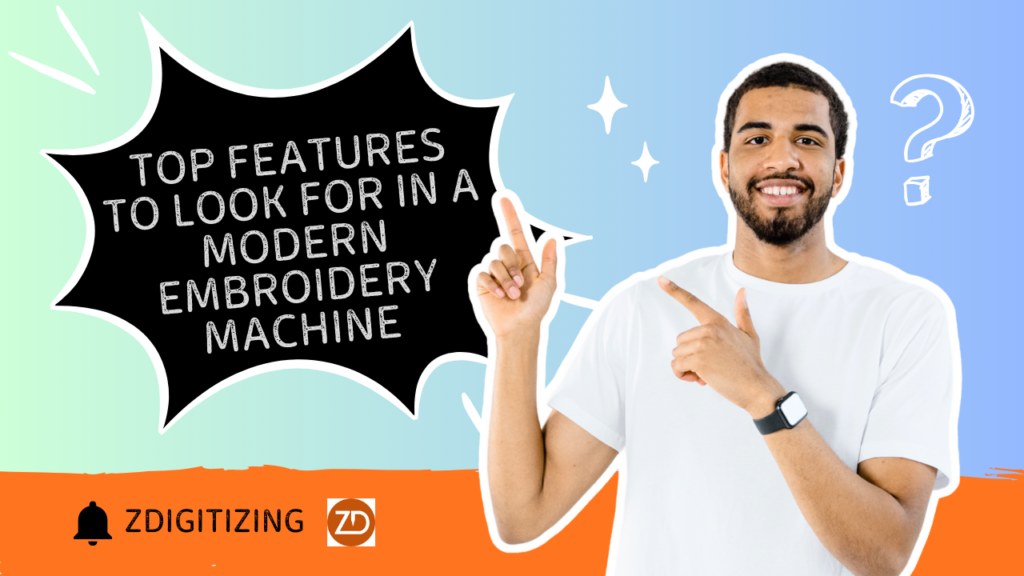In 2025, embroidery machines have evolved into powerful tools that blend technology and creativity, making them essential for hobbyists, small businesses, and professional crafters. Whether you’re personalizing gifts, branding apparel, or crafting intricate designs, choosing a modern embroidery machine with the right features ensures efficiency, quality, and ease. From wireless connectivity to expansive design libraries, the latest models cater to beginners and pros alike. This blog highlights the top features to prioritize when selecting a modern embroidery machine, helping you find the perfect match for your projects, whether paired with professional digitizing services like ZDigitizing or used for DIY designs.
Why Choose a Modern Embroidery Machine?
Modern embroidery machines offer advanced capabilities that streamline workflows and elevate output. Features like touchscreen interfaces, automatic threading, and large embroidery fields simplify complex tasks, while compatibility with custom files (e.g., PES, DST) supports unique designs. For users of machines like the Brother SE700 or NS1150E, these advancements mean faster setups, fewer errors, and professional-grade results on hats, shirts, or quilts. Understanding key features ensures you invest in a machine that grows with your skills and meets your creative goals.
Top Features to Look for in 2025
Here are the must-have features to consider when shopping for a modern embroidery machine:
1. Large and Versatile Embroidery Area
-
What to Look For: A spacious embroidery field (e.g., 5×7 inches or larger) for bigger designs like jacket logos or quilt blocks. Multi-position hoops or optional larger hoops add flexibility.
-
Why It Matters: Larger areas reduce repositioning, saving time on complex projects. For example, the Brother NS1150E’s 5×7-inch hoop handles bigger motifs than the SE700’s 4×4-inch field.
-
Example: A 5×7-inch hoop is ideal for church banners, while a 4×4-inch hoop suits small logos on caps.
Tip: Check if the machine supports multiple hoop sizes for versatility across projects.
2. Built-In Designs and Fonts
-
What to Look For: A robust library of built-in embroidery designs (100+) and fonts (5–10) for monogramming and customization without external files.
-
Why It Matters: Extensive libraries jumpstart creativity, especially for beginners. Machines like the Brother SE725 offer 135 designs and 10 fonts, plus access to iBroidery for thousands more.<grok:render type=”render_inline_citation”>0</grok:render>
-
Example: Built-in floral patterns or religious motifs save time for quick gift projects.
Tip: Look for machines with iBroidery or similar platform access for downloadable designs.
3. Wireless Connectivity and App Integration
-
What to Look For: Wi-Fi or LAN for transferring designs from a phone or PC via apps like Brother’s Artspira or Design Database Transfer software.
-
Why It Matters: Wireless eliminates USB hassles, speeding up custom file uploads from services like ZDigitizing. The Brother SE700’s Artspira app lets users draw and send designs directly.<grok:render type=”render_inline_citation”>7</grok:render>
-
Example: Upload a PES file for a logo to your machine in seconds without cables.
Tip: Ensure the app is user-friendly; check reviews for glitch-free performance.
4. Color LCD Touchscreen for Editing
-
What to Look For: A clear, color touchscreen (3–7 inches) with on-screen editing for resizing, rotating, and previewing designs with zoom (up to 200%).
-
Why It Matters: Intuitive editing reduces reliance on external software. The Brother PE545’s 3.2-inch LCD simplifies adjustments for beginners.
-
Example: Rotate a monogram on-screen to fit a shirt pocket perfectly.
Tip: Larger screens (4+ inches) enhance precision for complex designs.
5. Automatic Features for Ease of Use
-
What to Look For: Auto needle threader, thread cutter, and quick-set bobbin to streamline setup and finishing.
-
Why It Matters: These save time and reduce frustration, especially for multi-color designs. The Brother SE725’s auto-threader is a beginner favorite.
-
Example: Auto-cut threads between color changes speed up logo stitching.
Tip: Look for adjustable speed controls to balance precision and efficiency.
6. Compatibility with Custom File Formats
-
What to Look For: Support for multiple file formats (PES, DST, JEF, EXP) to handle custom designs from digitizing services or software.
-
Why It Matters: Compatibility ensures seamless use of files from ZDigitizing or platforms like Embrilliance. Brother machines like the NS1150E excel with PES files.
-
Example: Import a custom PES logo for a team jacket without conversion issues.
Tip: Verify format support in the machine’s manual to match your digitizing needs.
Conclusion
In 2025, modern embroidery machines like the Brother SE700, NS1150E, or PR680W offer game-changing features for crafters at all levels. Prioritize large embroidery areas, wireless connectivity, intuitive touchscreens, and custom file support to unlock professional results. Whether you’re stitching monograms or branding apparel, these features ensure efficiency and quality. Combine your machine with services like ZDigitizing for flawless custom files, and you’ll transform fabric into art with ease. Choose wisely, and your embroidery machine will be a creative powerhouse for years.
Frequently Asked Questions (FAQs)
What’s the best embroidery area for beginners?
A 4×4-inch hoop (e.g., Brother SE700) is great for small logos; 5×7 for larger designs.
Do I need wireless connectivity?
It’s a time-saver for custom files but not essential if you’re comfortable with USB.
Can modern machines handle custom designs?
Yes, with formats like PES or DST from services like ZDigitizing.
What’s a good budget for an embroidery machine?
$400–$600 for starters (SE725); $800–$1,500 for mid-range (NS1150E).

